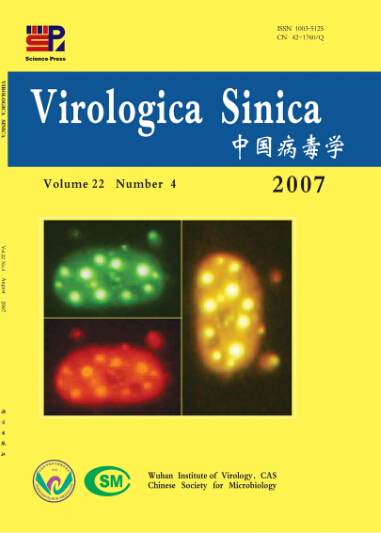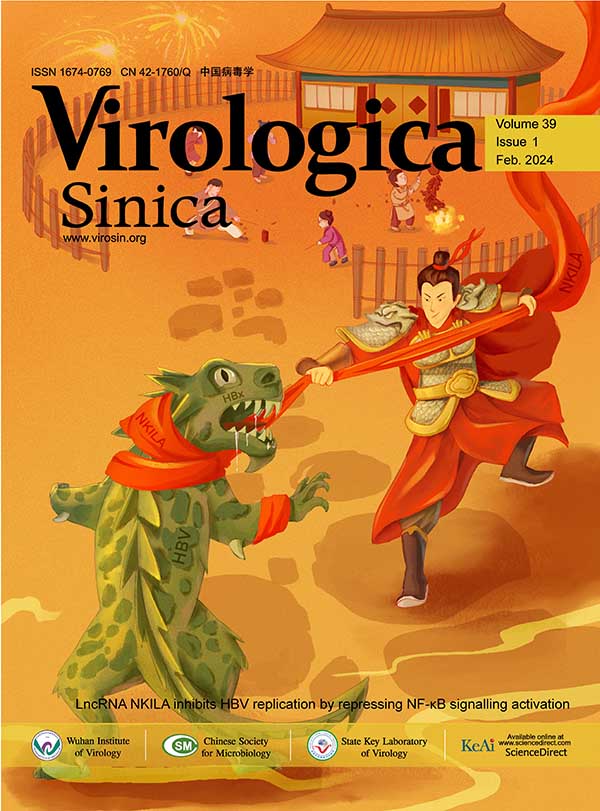Phylogenetic Analysis of Orgyia pseudotsugata Single-nucleocapsid Nucleopolyhedrovirus*
2007, 22(4): 257
Received: 28 March 2007
Accepted: 10 April 2007
The Douglas-fir tussock moth Orgyia pseudotsugata (Lepidoptera: Lymantriidae) is a frequent defoliator of Douglas-fir and true firs in western USA and Canada. A single nucleopolyhedrovirus (SNPV) isolated from O. pseudotsugata larvae in Canada (OpSNPV) was previously analyzed via its polyhedrin gene, but is phylogenetic status was ambiguous. Sequences of four conserved baculovirus genes, polyhedrin, lef-8, pif-2 and dpol, were amplified from OpSNPV DNA in polymerase chain reactions using degenerate primer sets and their sequences were analyzed phylogenetically. The analysis revealed that OpSNPV belongs to group II NPVs and is most closely related to SNPVs that infect O. ericae and O. anartoides, respectively. These results show the need for multiple, concatenated gene phylogenies to classify baculoviruses.
Efficient Gene Transfer Mediated by HIV-1-based Defective Lentivector and Inhibition of HIV-1 Replication
2007, 22(4): 266
Received: 06 February 2007
Accepted: 10 May 2007
Lentiviral vectors have drawn considerable attention recently and show great promise to become important delivery vehicles for future gene transfer manipulation. In the present study we have optimized a protocol for preparation of human immunodeficiency virus type-1 (HIV-1)-based defective lentiviral vectors (DLV) and characterized these vectors in terms of their transduction of different cells. Transient co-transfection of 293T packaging cells with DNA plasmids encoding lentiviral vector constituents resulted in production of high-titer DLV (0.5-1.2 × 107IU/mL), which can be further concentrated over 100-fold through a single step ultracentrifugation. These vectors were capable of transducing a variety of cells from both primate and non-primate sources and high transduction efficiency was achieved using concentrated vectors. Assessment of potential generation of RCV revealed no detection of infection by infectious particles in DLV-transduced CEM, SupT-1 and MT-2 cells. Long-term culture of transduced cells showed a stable expression of transgenes without apparent alteration in cellular morphology and growth kinetics. Vector mobilization to untransduced cells mediated by wild-type HIV-1 infection was confirmed in this test. Challenge of transduced human T-lymphocytes with wild-type HIV-1 showed these cells are totally resistant to the viral infection. Considering the effective gene transfer and stable gene expression, safety and anti-HIV activity, these DLV vectors warrant further exploration for their potential use as a gene transfer vehicle in the development of gene therapy protocols.
Expression of HSV-1 ICP0 Antigen Peptide in Prokaryotic Cells and Preparation of Specific Antibody*
2007, 22(4): 280
Received: 06 December 2006
Accepted: 27 March 2007
As an immediate-early protein of herpes simplex virus, infected-cell polypeptide 0 (ICP0) exhibits complicated interactions with host cells, and its regulatory function on gene expression is of great importance. Since the ICP0 encoding sequence contains many rare codons which are absent in E.coli, and ICP0 is highly unstable in prokaryotic cells, expression of entire ICP0 in prokaryotic cells has never been reported. In order to further investigate the function of ICP0, a recombinant plasmid was constructed by subcloning a cDNA fragment encoding an amino-terminal of 105 residues of the ICP0 protein into pGEX-5x-1 vector. The resulting GST-105 fusion antigen peptide was expressed with high efficiency in E.coli. Antibodies prepared after the immunization of mice with purified fusion protein can recognize not only the denatured ICP0 protein, but also the native ICP0 protein with normal biological conformation.
Expression and Immunoreactivity of a Human Group A Rotavirus Vp4
2007, 22(4): 287
Received: 05 December 2006
Accepted: 16 March 2007
Rotavirus capsid protein Vp4 plays an important role in the virus adhering and entering the cells. In this study, a Vp4 gene cloned from a rotavirus strain TB-Chen was highly expressed in E.coli BL21 (DE3). The results of the Western blot showed that the protein possesses specific immuno-reactivities and can be specifically recognized by guinea pig antibodies against rotavirus strain SA11 or Wa. Some Vp4 dimers were formed during renaturation. These data obtained from this study provide a strong basis for further study on the structure and function of the Vp4.
Sequence Analysis of Segment 8 of Five Chinese Isolates of Rice Gall Dwarf Virus and Expression of a Main Outer Capsid Protein in Escherichia coli*
2007, 22(4): 294
Received: 09 January 2007
Accepted: 09 May 2007
The rice gall dwarf disease, caused by the Rice gall dwarf virus (RGDV) is a serious disease occurring in rice in many regions of Guangdong province. As a basis to control the disease we have studied the genomic diversity of a variety of isolates from different locations. Genome segment 8(S8), encoding a main outer capsid protein (Pns8) of RGDV five isolates (BL, CH, DQ, GZ, XY) from Guangdong province was cloned and sequenced. The results revealed that all the S8 segments of the five isolates consisted of 1 578 nucleotides and had a single open reading frame (ORF) extending for 1 301 nucleotides from nucleotide 21 which encoded a polypeptide of 426 amino acids with an estimated molecular weight of 47.4 kDa. The S8 full-length sequence and the ORF sequence shared 97.3%-98.8% and 97.3%-99.1% nucleotide sequence identities within the five Chinese isolates, and shared 94.8%-95.6% and 95.0%-96.0% identities with those of the Thailand isolate respectively. The deduced amino acid sequence of Pns8 in GZ isolate was identical to that in the Thailand isolate, while the amino acid sequence variability of Pns8 within five Chinese isolates ranged from 0.5% to 2.1%. These results indicate that the S8 segment of RGDV is highly conserved in different isolates from different locations. The S8 cDNA from the XY isolate was cloned into the plasmid vector pET-28b(+) and a fused expression protein with an apparent molecular mass of 51kDa was specifically detected in an analysis of Escherichia coli Rossetta(DE3)Ⅱcells. To our knowledge, this is the first report on analysis of the RGDV segment 8 sequence and genetic comparison of different RGDV isolates and their protein expression.
Relationship of HLA-A, -Cw Polymorphisms with HIV/AIDS in Chinese Yi Ethnic Group of Sichuan Province*
2007, 22(4): 301
Received: 15 January 2007
Accepted: 10 May 2007
The relationship of HLA-A, -Cw alleles on HIV infection and AIDS disease progression in the Chinese Yi ethnic group of Sichuan province were investigated. The genetic polymorphisms of HLA-A, -Cw alleles of 102 unrelated healthy Chinese Yi ethnic individuals, 68 HIV-1 infected and 21 HIV positive long-time survivors were typed by PCR-SSP assay. Statistic signifiance was determined by the χ2 test with the SPSS software. No significant differences were observed between the HLA-A, -Cw alleles of the 68 HIV-1 infected and 102 non-infected Chinese Yi control individuals. Whereas the prevalence of A*3601,Cw*14(01-03)and Cw*0304 was significantly higher in 21 long time survivors compared with 102 healthy controls with P values of 0.016, 0.016 and 0.000 by χ2 or the Fisher exact test respectively. The result implies that A*3601,Cw*14(01-03) and Cw*0304 may be associated with slow AIDS disease progression in the Chinese Yi ethnic group, further studies on this association may yield insight on the pathogenesis of HIV-1 infection.
Detection and Genetic Characterization of Rabies Virus from Human Patients*
2007, 22(4): 307
Received: 06 January 2007
Accepted: 24 April 2007
Saliva and blood were collected from two patients who had not received post exposure prophylaxis in the cities of Wenzhou and Xinning respectively. Both patients were confirmed as positive for rabies by detection of rabies virus specific nucleoprotein antibodies in the sera by Western Blot. However, rabies virus specific RNA was only identified in the saliva collected from the patient in Wenzhou. Furthermore, the isolate Zhejiang Wz0 (H) was obtained by inoculating one-day-old suckling mice. Both nucleoprotein (N) and glycoprotein (G) genes from the isolate were amplified by RT-PCR and sequenced. Phylogenetic analysis indicated that the isolate belonged to classic rabies virus, and shared a higher homology with the street viruses from dogs in the main endemic areas in China and the street virus from dogs in Indonesia than with other known strains. Further comparison of the deduced amino acid sequences between the isolate and the vaccine strains used in China showed that the virus had a higher level of homology with the vaccine strain CTN than with the other vaccine strains (3aG, PV, PM and ERA). In particular, amino acid residues substitutions located in antigenic site Ⅲ in the G protein, which could react with the neutralizing antibodies, were observed. These results suggested that the virus belonged to the classic rabies virus, and both N and G genes diverged from the current vaccine strains used in China at either the nucleotide or the amino acid level.
Tn7-mediated Introduction of DNA into Bacmid-cloned Pseudorabies Virus Genome for Rapid Construction of Recombinant Viruses*
2007, 22(4): 316
Received: 04 April 2007
Accepted: 18 May 2007
lacZα-mini-attTn7 was inserted into the intergenic region between the gG and gD genes in a PRV bacterial artificial chromosome (BAC) by homologous recombination in E. coli. The resulting recombinant BAC (pBeckerZF1) was confirmed by PCR and sequencing. Green fluorescent protein (GFP) gene was then transposed into pBeckerZF1 by transposon Tn7 to generate pBeckerZF2. Recombinant viruses vBeckerZF1 and vBeckerZF2 were generated by transfection with the corresponding BAC pBeckerZF1 or pBeckerZF2. The titers and cytopathic effect (CPE) observed for by vBeckerZF1 and vBeckerZF2 was comparable to that of the parental virus vBecker3. vBeckerZF2 was serial passaged for five rounds in cell culture, and the mini-Tn7 insertion was stably maintained in viral genome. These results show that recombinant viruses can be rapidly and reliably created by Tn7-mediated transposition. This technology should accelerate greatly the pace at which recombinant PRV can be generated and, thus, facilitate the use of recombinant viruses for detailed mutagenic studies.
A Strategy to Optimize the Oligo-Probes for Microarray-based Detection of Viruses*
2007, 22(4): 326
Received: 08 January 2007
Accepted: 20 May 2007
DNA microarrays have been acknowledged to represent a promising approach for the detection of viral pathogens. However, the probes designed for current arrays could cover only part of the given viral variants, that could result in false-negative or ambiguous data. If all the variants are to be covered, the requirement for more probes would render much higher spot density and thus higher cost of the arrays. Here we have developed a new strategy for oligonucleotide probe design. Using type I human immunodeficiency virus (HIV-1) tat gene as an example, we designed the array probes and validated the optimized parameters in silico. Results show that the oligo number is significantly reduced comparing with the existing methods, while specificity and hybridization efficiency remain intact. The adoption of this method in reducing the oligo numbers could increase the detection capacity for DNA microarrays, and would significantly lower the manufacturing cost for making array chips.

















